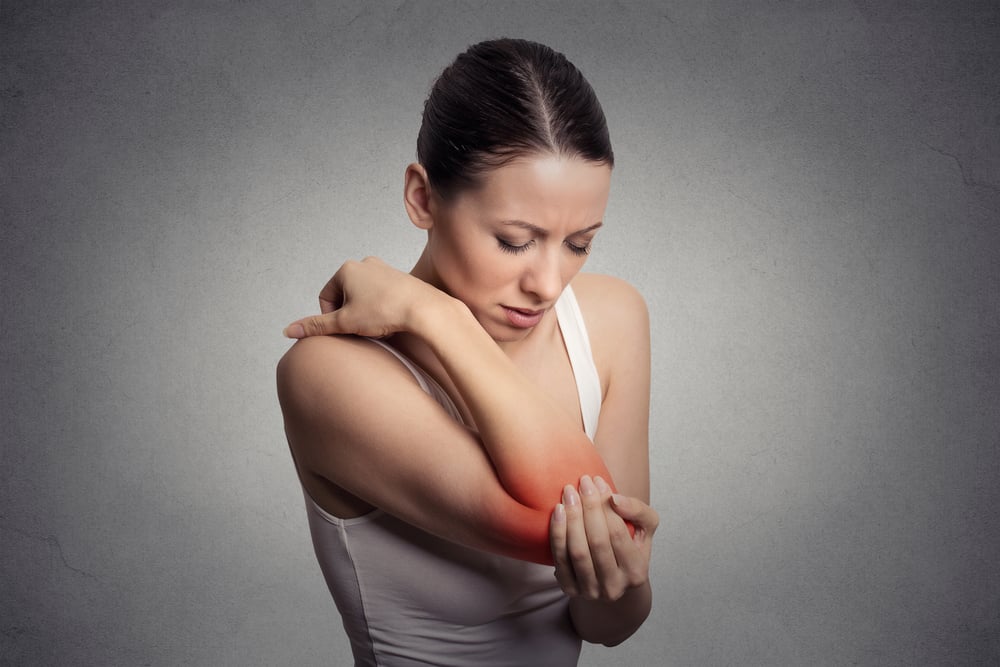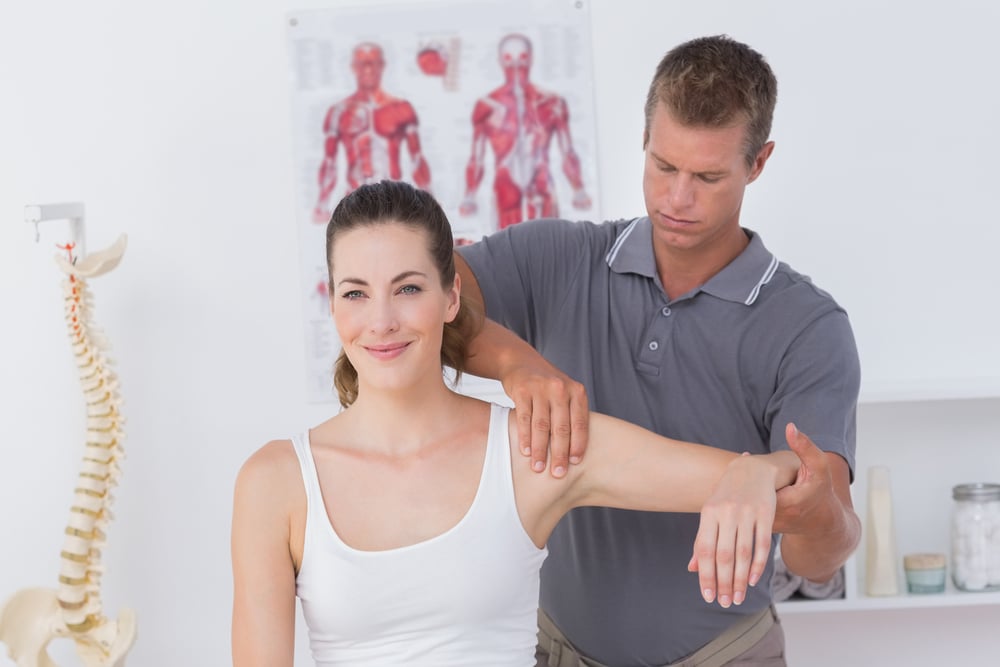Tennis Elbow: Causes, Symptoms, and Risk Factors
5 min read

If you’re experiencing pain in the outer part of your elbow it can be hard to do a lot of everyday activities. There’s a good chance it’s tennis elbow. Living in The Woodlands area, there are a lot of tennis players who experience this. But, unlike its namesake, tennis elbow affects more people than just tennis players!
What is Tennis Elbow?
Tennis elbow is a painful condition that can happen to just about anyone who overuses their elbow joint with repetitive movements. The repetitive motion causes inflammation, swelling, pain, and stiffness in the elbow. This is also called elbow tendinitis.
The pain is usually felt near where the muscles of the forearm attach to the bony bump on the outside of your elbow. The pain can run down your arm to your wrist. Because this type of elbow tendonitis is on the outside of the elbow, it’s often related to the backhand swing of a tennis player, or other similar repetitive movements. Golfer’s elbow is tendinitis on the inside of the elbow.
Common Causes of Tennis Elbow
The most common causes of elbow tendonitis include any repetitive motion, such as sports, gardening or pruning shrubs, hammering nails, shoveling, carrying heavy loads, or using machinery where you must repeatedly grip or pull a lever. You can even irritate your elbow by leaning on it while sitting at a desk or during a long drive.
With the exception of an injury, most elbow tendonitis develops over time. Repeatedly straining and/or tugging the muscles can cause tiny tears in the tendons. If the tears are not allowed to heal fully, the problem can worsen. Inflammation and pain will continue without rest and treatment.
Symptoms of Tennis Elbow
Symptoms can vary from mild irritation to pain that is so severe you can't use the affected arm. The pain can change in intensity from day to day, from a dull ache to burning. You may also have weakness in your hand grip and/or numbness in the hand or fingers. You may first notice the pain caused by inflammation when you pick up a coffee cup, turn a doorknob or shake hands.
Inflammation is how your body protects itself when you have an injury or irritation from overuse. Inflammation symptoms include redness and warmth, swelling, soreness, and pain.
You’ll notice that the elbow pain is on the outside of your elbow if it’s tennis elbow. The pain may spread down the arm to your middle and ring fingers. In addition to pain with movement, your forearm may also feel tight and sore. Common signs include worse pain when you hold something with your elbow and/or wrist straight. It may also be painful to bend your wrist backward or turn your palm facing up.
It's time to see a doctor if you cannot use your arm or carry an object with the affected arm. Other concerning symptoms include pain at night or while resting your arm. You may not be able to straighten or flex your arm. You may notice significant swelling or bruising around the elbow joint if the pain is getting worse or continues beyond a few days. Even with rest and inflammation-reducing pain meds, it's time to contact your doctor.
What Increases Your Risk of Developing Tennis Elbow?
Risk factors that increase the likelihood of having this form of tendonitis include:
- Age – it's more common in people between the ages of 30 to 50
- "Weekend warrior syndrome" where you try to "do it all" in a weekend – a sports competition, trimming all your hedges, raking your yard, painting the house, even knitting
- Occupations that have a high risk for elbow tendonitis include butchers, carpenters, painters, plumbers, and people who regularly use a mouse and keyboard.
- Sports that involve repetitive movements: weight-lifting, archery, baseball or football, fencing, or any sport using a racquet can increase your risk for tendonitis. Using the incorrect form for a golf swing or when lifting heavy objects can catch up to you.
- Direct injury to the elbow area is the least common cause.
Ways to Prevent Tennis Elbow
The most effective way to prevent this type of tendonitis is to avoid overuse. As soon as you feel pain during any activity, stop and ice the area for 15 minutes, three to four times a day before any activity using your elbow, stretch, and warm-up.
The wrong equipment can also stress your elbow. For example, carpenters may want to try a hammer with a softer grip. Check with a tennis professional to be sure your equipment isn't too heavy or the grip too big. While you're talking to the pro, get an evaluation of your swing. Even something so seemingly minor as your posture during your swing can cause a painful reaction in the elbow.
Chiropractic Treatments for Tennis Elbow
The good news is, this problem usually goes away if you stop the activity that caused it. With most types of tendonitis, rest is the key. You have to stop the motion that caused the problem, and other motions like it.
Resting the joint is essential to healing. Many people get relief with over-the-counter pain and anti-inflammatory medications. Try ice packs to the painful area for 15 minutes, three to four times a day, for two to three days.
Your chiropractor may also recommend range-of-motion exercises to strengthen and stretch the muscles. You might also try an elbow strap or brace. This is a padded strap that fits over the affected elbow to provide support and reduce pain by stabilizing elbow tendons.
It can also be helpful to use the skills of a professional massage therapist that can relieve some of the pain associated with tennis elbow. We have a massage therapist on staff to help with these issues.
Be patient with this type of injury, and do not rush your recovery. Resuming the same activity too soon can make the pain return almost right away. It can even cause permanent damage if the pain is ignored.
Be sure you can do these things without pain before returning to your normal activities:
- Bear weight on your arm and elbow without pain
- Grasp objects without pain
- Have the same strength in both elbows, arms, and wrists
- Have the same amount of flexibility and movement in both arms
- Swelling and soreness are gone
Note that some doctors will suggest steroid injections to help relieve this pain. Studies have shown that while they can help with pain in the short term, do not help in the long run. You really have to give your elbow a rest to completely recover.
Get Chiropractic Care for Tennis Elbow
If you still have pain and soreness after several months, you may want to consider chiropractic treatment. Many people find that chiropractic treatment is an effective way to treat chronic arm and elbow pain without surgery. A growing list of research studies shows that chiropractic treatment is effective, safe, and affordable.
Some of the treatments for tennis are available at Village Chiropractic include manipulation, massage, cold laser therapy, and electrical muscle stimulation.
The experienced chiropractors at Village Chiropractic in The Woodlands are patient-centered and results-driven. We use a variety of approaches that can help you avoid further injury or even surgery. Contact us today to schedule an appointment to see what’s going and what we can do to help.





